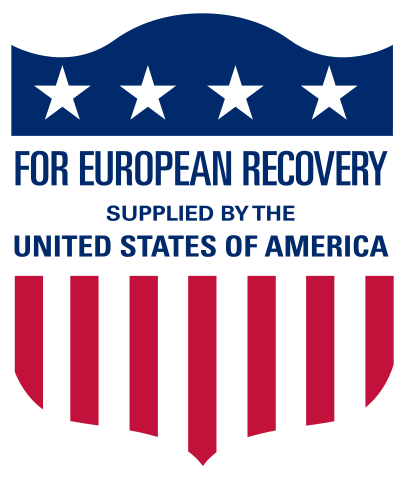More languages
More actions
(Created) Tag: Visual edit |
General-KJ (talk | contribs) (Expanded the article) Tag: Visual edit |
||
| Line 1: | Line 1: | ||
The '''Marshall Plan''' was a [[United States of America|U.S.]] economic policy that put Western Europe under U.S. | [[File:US-MarshallPlanAid-Logo.svg.png|thumb|Marshall Plan propaganda]] | ||
The '''Marshall Plan''' was a [[United States of America|U.S.]] economic policy that put Western [[Europe]] under the control of [[United States imperialism|U.S. imperialism]] not long after the end of the [[Second World War]] under the guise of recovery and development plan.<ref name=":0222222">{{Citation|author=David Vine|year=2020|title=The United States of War|chapter=The Spoils of War|page=283–4|city=Oakland|publisher=University of California Press|isbn=9780520972070|lg=http://library.lol/main/191568BFAC73F009132DB00ECD0F0F05}}</ref> It stabilized [[capitalism]] to prevent [[Proletarian revolution|revolution]].<ref name=":03">{{Citation|author=Roger Keeran, Thomas Kenny|year=2010|title=Socialism Betrayed: Behind the Collapse of the Soviet Union|chapter=Conclusions and Implications|page=246|pdf=https://ipfs.io/ipfs/bafykbzaceaj5ucph44bjwyhlhsbycckr3ts76zbucn2hbrea32tltcd4s5ekg?filename=Roger%20Keeran_%20Thomas%20Kenny%20-%20Socialism%20Betrayed_%20Behind%20the%20Collapse%20of%20the%20Soviet%20Union-iUniverse.com%20%282010%29.pdf|publisher=iUniverse.com|isbn=9781450241717}}</ref> | |||
== History == | |||
The idea of the Marshall plan was first set forth by [[George C. Marshall]], then U.S. Secretary of State under [[Harry S. Truman]], on June 5, 1947. The [[Imperialism|imperialist]] powers of [[United Kingdom of Great Britain and Northern Ireland|Britain]] and [[French Republic|France]] were in full support of the plan and at first the [[Union of Soviet Socialist Republics (1922–1991)|Soviet Union]] was open to the offer, however, when the Soviets attempted to counterbalance the plan by introducing a proposal aimed at ensuring equal cooperation whilst respecting states national sovereignty, this proposal was rejected by the [[Imperial core|West]]. This now blatant display of the true aims of the plan led the Soviets and the rest of [[Socialism|socialist]] Europe to refuse to join the plan.<ref name=":0">{{Citation|author=D. S. Asanov|year=1979|title=The Great Soviet Encyclopedia|title-url=https://encyclopedia2.thefreedictionary.com/Marshall+plan|chapter=Marshall Plan}}</ref> | |||
The plan was initially joined by the capitalist states of Britain, France, [[Italian Republic|Italy]], [[Kingdom of Belgium|Belgium]], the [[Kingdom of the Netherlands|Netherlands]], [[Grand Duchy of Luxembourg|Luxembourg]], [[Kingdom of Sweden|Sweden]], [[Kingdom of Norway|Norway]], [[Kingdom of Denmark|Denmark]], [[Republic of Ireland|Ireland]], [[Iceland]], [[Portuguese Republic|Portugal]], [[Republic of Austria|Austria]], [[Swiss Confederation|Switzerland]], [[Hellenic Republic|Greece]], and [[Republic of Türkiye|Turkey]], with [[Federal Republic of Germany|West Germany]] joining later. The plan began operating in April 1948 and agreements with each of the participating nations were signed the same year with the exception of Switzerland which joined the plan but refused to sign an agreement.<ref name=":0" /> | |||
From April 1948 to December 1951 the U.S. spent approximately $17 bn on the plan with around 60% of the aid going to was received by Britain, France, Italy, and West Germany. On December 30, 1951, the Marshall Plan expired and was replaced by the [[Mutual Security Act]] to continue spreading military and economic aid to U.S. allies.<ref name=":0" /> | |||
== References == | == References == | ||
[[Category:Imperialism]] | |||
[[Category:Neocolonialism]] | [[Category:Neocolonialism]] | ||
Latest revision as of 20:46, 17 August 2024

The Marshall Plan was a U.S. economic policy that put Western Europe under the control of U.S. imperialism not long after the end of the Second World War under the guise of recovery and development plan.[1] It stabilized capitalism to prevent revolution.[2]
History[edit | edit source]
The idea of the Marshall plan was first set forth by George C. Marshall, then U.S. Secretary of State under Harry S. Truman, on June 5, 1947. The imperialist powers of Britain and France were in full support of the plan and at first the Soviet Union was open to the offer, however, when the Soviets attempted to counterbalance the plan by introducing a proposal aimed at ensuring equal cooperation whilst respecting states national sovereignty, this proposal was rejected by the West. This now blatant display of the true aims of the plan led the Soviets and the rest of socialist Europe to refuse to join the plan.[3]
The plan was initially joined by the capitalist states of Britain, France, Italy, Belgium, the Netherlands, Luxembourg, Sweden, Norway, Denmark, Ireland, Iceland, Portugal, Austria, Switzerland, Greece, and Turkey, with West Germany joining later. The plan began operating in April 1948 and agreements with each of the participating nations were signed the same year with the exception of Switzerland which joined the plan but refused to sign an agreement.[3]
From April 1948 to December 1951 the U.S. spent approximately $17 bn on the plan with around 60% of the aid going to was received by Britain, France, Italy, and West Germany. On December 30, 1951, the Marshall Plan expired and was replaced by the Mutual Security Act to continue spreading military and economic aid to U.S. allies.[3]
References[edit | edit source]
- ↑ David Vine (2020). The United States of War: 'The Spoils of War' (pp. 283–4). Oakland: University of California Press. ISBN 9780520972070 [LG]
- ↑ Roger Keeran, Thomas Kenny (2010). Socialism Betrayed: Behind the Collapse of the Soviet Union: 'Conclusions and Implications' (p. 246). [PDF] iUniverse.com. ISBN 9781450241717
- ↑ 3.0 3.1 3.2 D. S. Asanov (1979). The Great Soviet Encyclopedia: 'Marshall Plan'.
